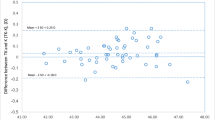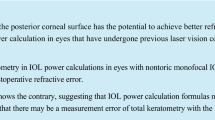Abstract
Purpose
This study aims to compare postoperative refractive error results using Pentacam (Oculus Optikgeräte GmbH) Holladay equivalent keratometry readings (EKR) or IOLMaster 700 (Carl Zeiss Meditec AG) keratometry (K) values in IOL power calculation.
Material and methods
This retrospective study included 54 eyes of 31 patients who underwent cataract surgery. Preoperative biometric measurements of all patients were obtained using IOLMaster 700 followed by Pentacam measurements. IOLMaster 700 K measurements on horizontal (K1) and vertical (K2) axes and EKR measurements on 2 mm (EKR2mm), 3 mm (EKR3mm) and 4.5 mm (EKR4.5 mm) corneal zones were recorded. EKR4.5 mm value and IOLMaster 700 K values were used in Holladay-II, SRK/T, Haigis, and Hoffer-Q formulas to calculate predictive refractive error (PRE). Absolute refractive error (ARE) was calculated as the absolute difference between actual postoperative refractive error (APRE) and PRE values.
Results
Mean age was 72.2 ± 8.3 (51–87) years and mean IOL power was 21.5 ± 2.9 D (18–23 D). There was no significant difference between PRE values when IOLMaster 700 K measurements and EKR4.5 mm K measurements were used in Holladay-II, SRK/T, Haigis, and Hoffer-Q formulas (p = 0.571, p = 0.833, p = 0.165, p = 0.347, respectively). There was no significant difference between APRE and ARE values (p = 0.124). According to mean ARE results, the closest estimate was achieved when the IOLMaster 700 K values were used in the Holladay-II formula (p = 0.271).
Conclusion
IOLMaster 700 K measurement and Pentacam EKR4.5 mm measurements can be used interchangeably. IOLMaster 700 K values yielded the most predictive measurement of the refractive result using the Holladay-II formula.
Similar content being viewed by others
Data availability
Data sharing is not applicable to this article.
References
Moschos MM, Chatziralli IP, Koutsandrea C (2014) Intraocular lens power calculation in eyes with short axial length. Indian J Ophthalmol 62:692–694
Wang JK, Chang SW (2013) Optical biometry intraocular lens power calculation using different formulas in patients with different axial lengths. Int J Ophthalmol 6:150–154
Alio JL, Grzybowski A, El Aswad A, Romaniuk D (2014) Refractive lens exchange. Surv Ophthalmol 59:579–598
Norrby S (2008) Sources of error in intraocular lens power calculation. J Cataract Refract Surg 34:368–376
Olsen T (2007) Calculation of intraocular lens power: a review. Acta Ophthalmol Scand 85(5):472–485
Fontes BM, Fontes BM, Castro E (2011) Intraocular lens power calculation by measuring axial length with partial optical coherence and ultrasonic biometry. Arq Bras Oftalmol 74:166–170
Olsen T (1986) On the calculation of power from curvature of the cornea. Br J Ophthalmol 70:152–154
Fam HB, Lim KL (2007) Validity of the keratometric index: large population-based study. J Cataract Refract Surg 33:686–691
Asena L, Akman A, Gungor SG, Dursun AD (2018) Comparison of Keratometry Obtained by a Swept Source OCT-Based Biometer with a Standard Optical Biometer and Scheimpflug Imaging. Curr Eye Res 43:882–888
Huseynli S, Abdulaliyeva F (2018) Evaluation of scheimpflug tomography parameters in subclinical keratoconus, clinical keratoconus and normal caucasian eyes. Turk J Ophthalmol 48:99–108
Srivannaboon S, Chirapapaisan C (2019) Comparison of refractive outcomes using conventional keratometry or total keratometry for IOL power calculation in cataract surgery. Graefes Arch Clin Exp Ophthalmol 257:2677–2682
Tang M, Wang L, Koch DD, Li Y, Huang D (2012) Intraocular lens power calculation after previous myopic laser vision correction based on corneal power measured by Fourier-domain optical coherence tomography. J Cataract Refract Surg 38:589–594
Qazi MA, Cua IY, Roberts CJ, Pepose JS (2007) Determining corneal power using Orbscan II videokeratography for intraocular lens calculation after excimer laser surgery for myopia. J Cataract Refract Surg 33:21–30
Kwitko S, Marinho DR, Rymer S, Severo N, Arce CG (2012) Orbscan II and double-K method for IOL calculation after refractive surgery. Graefes Arch Clin Exp Ophthalmol 250:1029–1034
Kirgiz A, Atalay K, Kaldirim H, Cabuk KS, Akdemir MO, Taskapili M (2017) Scheimpflug camera combined with placido-disk corneal topography and optical biometry for intraocular lens power calculation. Int Ophthalmol 37:781–786
Saad E, Shammas MC, Shammas HJ (2013) Scheimpflug corneal power measurements for intraocular lens power calculation in cataract surgery. Am J Ophthalmol. 156:460
Savini G, Hoffer KJ, Lomoriello DS, Ducoli P (2017) Simulated keratometry versus total corneal power by ray tracing: a comparison in prediction accuracy of intraocular lens power. Cornea 36:1368–1372
Shammas HJ, Hoffer KJ, Shammas MC (2009) Scheimpflug photography keratometry readings for routine intraocular lens power calculation. J Cataract Refract Surg 35:330–334
Akman A, Asena L, Gungor SG (2016) Evaluation and comparison of the new swept source OCT-based IOLMaster 700 with the IOLMaster 500. Br J Ophthalmol 100:1201–1205
Onay MPES, Üretmen Ö, Köse S (2011) Evaluation of cornea and anterior chamber using Pentacam in pediatric cases. Turk J Ophthalmol 41:133–137
Ho JD, Tsai CY, Tsai RJ, Kuo LL, Tsai IL, Liou SW (2008) Validity of the keratometric index: evaluation by the Pentacam rotating Scheimpflug camera. J Cataract Refract Surg 34:137–145
Huang J, Zhao Y, Savini G, Yu G, Yu J, Chen Z, Tu R, Zhao Y (2020) Reliability of a new swept-source optical coherence tomography biometer in healthy children, adults, and cataract patients. J Ophthalmol. 2020:8946364
Srivannaboon S, Chirapapaisan C, Chonpimai P, Loket S (2015) Clinical comparison of a new swept-source optical coherence tomography-based optical biometer and a time-domain optical coherence tomography-based optical biometer. J Cataract Refract Surg 41:2224–2232
Shankar H, Taranath D, Santhirathelagan CT, Pesudovs K (2008) Anterior segment biometry with the Pentacam: comprehensive assessment of repeatability of automated measurements. J Cataract Refract Surg 34:103–113
Zhou D, Sun Z, Deng G (2019) Accuracy of the refractive prediction determined by intraocular lens power calculation formulas in high myopia. Indian J Ophthalmol 67:484–489
Symes RJ, Say MJ, Ursell PG (2010) Scheimpflug keratometry versus conventional automated keratometry in routine cataract surgery. J Cataract Refract Surg 36:1107–1114
Seo KY, Im CY, Yang H, Kim TI, Kim EK, Kim T, Nam SM (2014) New equivalent keratometry reading calculation with a rotating Scheimpflug camera for intraocular lens power calculation after myopic corneal surgery. J Cataract Refract Surg 40:1834–1842
Holladay JT (2010) Accuracy of Scheimpflug Holladay equivalent keratometry readings after corneal refractive surgery. J Cataract Refract Surg. 36:182–183
Shajari M, Cremonese C, Petermann K, Singh P, Muller M, Kohnen T (2017) Comparison of axial length, corneal curvature, and anterior chamber depth measurements of 2 recently introduced devices to a known biometer. Am J Ophthalmol 178:58–64
Karunaratne N (2013) Comparison of the Pentacam equivalent keratometry reading and IOL Master keratometry measurement in intraocular lens power calculations. Clin Exp Ophthalmol 41:825–834
Song JS, Yoon DY, Hyon JY, Jeon HS (2020) Comparison of ocular biometry and refractive outcomes using IOL master 500, IOL master 700, and lenstar LS900. Korean J Ophthalmol 34:126–132
Symes RJ, Ursell PG (2011) Automated keratometry in routine cataract surgery: comparison of Scheimpflug and conventional values. J Cataract Refract Surg 37:295–301
Helaly HA, El-Hifnawy MA, Shaheen MS, Abou El-Kheir AF (2016) Accuracy of corneal power measurements for intraocular lens power calculation after myopic laser in situ Keratomileusis. Middle East Afr J Ophthalmol 23:122–128
Mandell KJ, Rudalevicius P, Jurkunas UV, II RP (2009) Determining the best pentacam EKR zone for IOL power calculations in postrefractive patients. Invest Ophthalmol Visual Sci 50:5082
Savini G, Barboni P, Profazio V, Zanini M, Hoffer KJ (2008) Corneal power measurements with the Pentacam Scheimpflug camera after myopic excimer laser surgery. J Cataract Refract Surg 34:809–813
Funding
This study was funded by Baskent University Research Fund.
Author information
Authors and Affiliations
Corresponding author
Ethics declarations
Conflict of interest
No conflicts of Interest.
Ethical approval
All procedures performed in studies involving human participants were in accordance with the ethical standards of the Institutional Ethics Review Board of Baskent University and with the 1964 Helsinki declaration and its later amendments or comparable ethical standards.
Human and animal rights
Patients signed informed consent regarding publishing their data and photographs.
Informed consent
Informed consent was obtained from all individual participants included in the study.
Additional information
Publisher's Note
Springer Nature remains neutral with regard to jurisdictional claims in published maps and institutional affiliations.
Rights and permissions
About this article
Cite this article
Aksoy, M., Asena, L., Güngör, S.G. et al. Comparison of refractive outcomes using Scheimpflug Holladay equivalent keratometry or IOLMaster 700 keratometry for IOL power calculation. Int Ophthalmol 41, 2205–2212 (2021). https://doi.org/10.1007/s10792-021-01781-6
Received:
Accepted:
Published:
Issue Date:
DOI: https://doi.org/10.1007/s10792-021-01781-6




